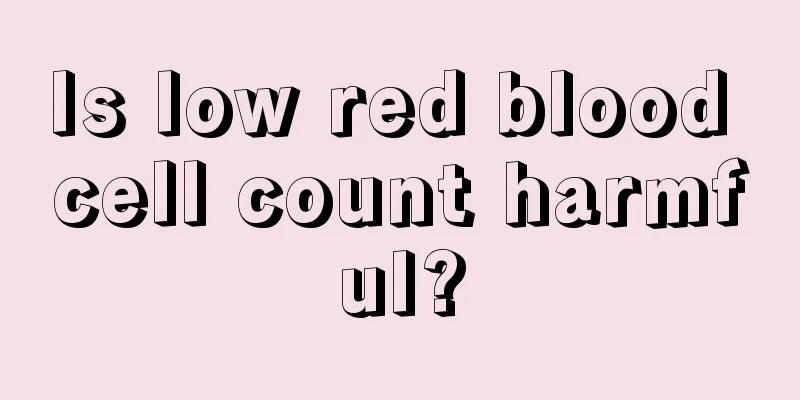Is low red blood cell count harmful?

|
Low red blood cell count is a common disease, which is mainly caused by decreased red blood cell production, excessive red blood cell destruction, various acute and chronic blood loss and other causes, which to a certain extent brings many adverse effects to patients. Therefore, red blood cells are the carriers of human respiration. Once their levels are low, breathing will become short, immune function will decline, and more diseases will follow. 1. Causes of low red blood cell count 1. Decreased red blood cell production: various chronic diseases such as aplastic anemia, leukemia, myeloma, myelofibrosis, etc., which lead to long-term consumption of the body, such as malignant tumors, uremia, liver disease, rheumatism, endocrine diseases, etc.; diseases caused by lack of hematopoietic substances or utilization disorders, such as iron deficiency anemia, sideroblastic anemia, megaloblastic anemia caused by folic acid or vitamin B12 deficiency. 2. A decrease in the number of red blood cells due to excessive destruction of red blood cells is common in hemolytic anemia, thalassemia, abnormal hemoglobin disease, paroxysmal nocturnal hemoglobinuria, immune hemolytic anemia, mechanical hemolytic anemia, etc. 3. Various acute and chronic blood loss, such as massive bleeding from trauma, massive bleeding from surgery, massive bleeding after childbirth, acute gastrointestinal bleeding, chronic blood loss caused by ulcers, and other chronic blood loss factors can lead to a decrease in the number of red blood cells. 2. The role of red blood cells Its main physiological function is to act as a respiratory carrier, carrying and releasing oxygen to tissues throughout the body, while transporting carbon dioxide, and synergistically regulating to maintain acid-base balance and immune adhesion. Immune adhesion can enhance the phagocytic effect of phagocytic leukocytes on microorganisms, eliminate the effects of antigen-antibody complexes, and prevent the complexes from forming potentially harmful precipitates in susceptible areas. 3. Examination of red blood cells Iron deficiency anemia is a common nutritional deficiency disease in children, which is more common in infants and young children aged 6 months to 3 years. Symptoms may include irritability, poor spirits, inactivity, fatigue, loss of appetite, pale lips, conjunctiva, nail beds and palms, etc. Immune macrophage proliferative disorders represent a group of etiologically diverse illnesses characterized by fever, hepatosplenomegaly, and pancytopenia. Blood examination can show low hemoglobin and red blood cell values, and biochemical tests such as serum ferritin and serum iron can confirm the diagnosis. |
<<: Is bioelectric meridian therapy really harmful?
>>: What are the dangers of low skeletal muscle?
Recommend
What are the summer vegetarian foods
We all know that when summer comes, because of th...
What vegetables are good for gout?
For gout patients, they must pay attention to car...
How to cure pituitary tumor
How to cure pituitary tumors? There are many pati...
What does the hepatitis B comparison table look like?
The hepatitis B control table refers to a referen...
Is liver cancer contagious if it is diagnosed in the hospital? Be alert to the two major causes of liver cancer
Nowadays, people's living conditions have imp...
Can I drink honey if I have nasopharyngeal cancer?
Nasopharyngeal cancer patients can drink honey wa...
Pu'er tea foot bath
Pu'er tea is quite famous in China . Many peo...
What are the side effects of chemotherapy for localized endometrial cancer? There are these 6 side effects
One of the side effects of chemotherapy for local...
Why does my back hurt when I bend over?
Moreover, many people often feel bursts of pain i...
Causes of impotence
The cause of impotence is unclear, because there ...
Can prostate cancer cause leg pain? A brief analysis of the symptoms of prostate cancer
Prostate cancer is a common disease in men. It ha...
Should patients with advanced lung cancer wear masks?
Do patients with advanced lung cancer need to wea...
What are the symptoms of Chlamydia infection
There are many types of mycoplasma, including Myc...
Things to know about drugs for advanced liver cancer
Liver cancer is a malignant tumor disease that oc...
What is the cause of acne in the inner corner of the eye
When we are in adolescence, it is easy for us to ...









